Pakenham Five-Span Bridge
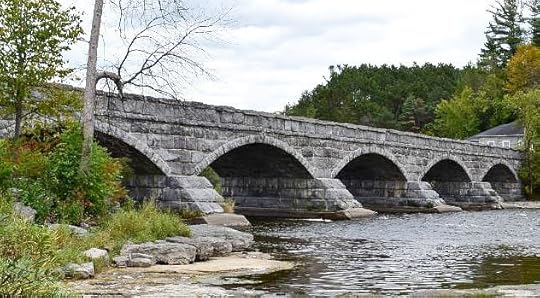
Pakenham
Five-Span Bridge
Original Bridge was Wooden
Like many other bridges in those days the original structure was built of wood, and the elements of heat and cold, freezing and thawing took their toll. The old wooden bridge needed frequent and costly repairs and it was decided that it would be a good time to construct a more durable bridge.
The Pakenham Township Councillors initially considered using iron which was popular at the time, but since the iron bridges were floored with wood they decided instead to build a stone bridge which would be longer lasting and more economical to repair. Plans were drawn for a five arch bridge, and a call for tenders was issued.
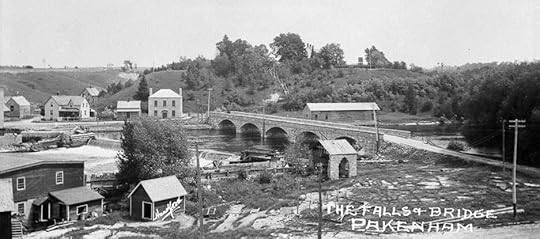
O’Toole and Keating of Ottawa
O’Toole and Keating of Ottawa won the bid, with an agreement to construct the bridge for $13,000. Ads were placed in local papers including the ‘Almonte Gazette’ and ‘The Perth Courier’ looking for bridge carpenters. They were offered an hourly wage of between $2.25 and $2.50, depending on experience, and a foremen would be hired at $3.00 per hour.
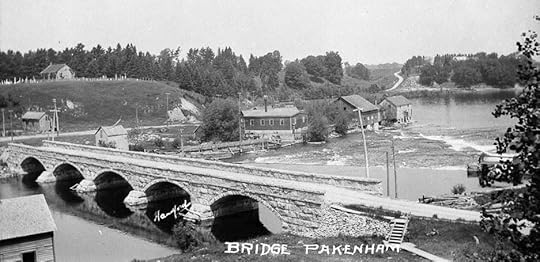
Building the Bridge
The work began on August 23, 1901 and was completed on October 23rd, an impressive seven weeks ahead of their proposed time limit. Seventy local men were employed. A steam-drill was used in the local quarry and a total of four sixty-foot mast derricks were used. It is believed that the quarry was located nearby.
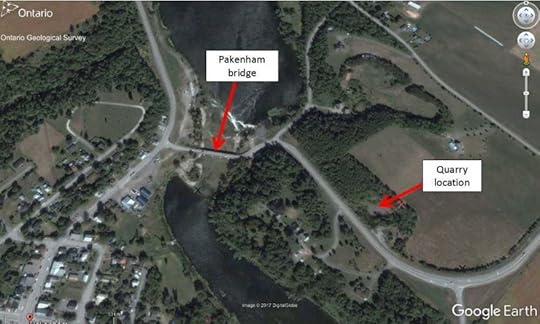
Limestone Quarry
The bridge was constructed from limestone rock. The largest limestone block in the bridge is about 9 feet long and about 2 and a half feet square, weighing over 5 tons. Limestone is an ideal material for this type of construction because it is resistant to heating and thawing, does not deteriorate when road salt is used, and is easier to mine than other similar types of rock.
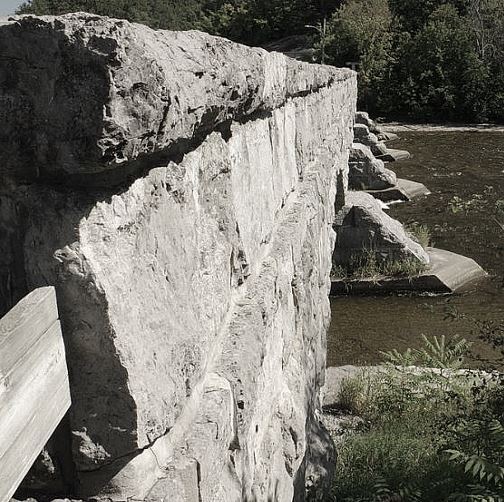
Massive limestone blocks cut from the local quarry
In the early 1900s there were an abundance of stone-cutters and mason who were skilled in cutting and shaping the limestone required for the bridge.
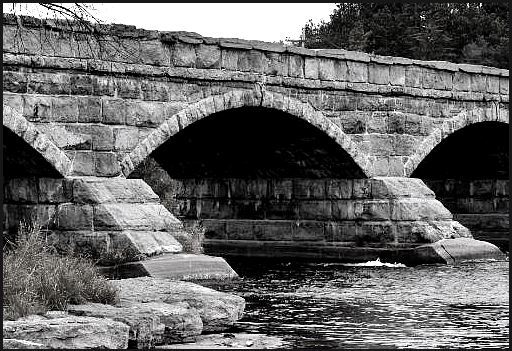
Five 40-Ft Arches
The finished bridge was 268 feet long with five forty-foot arches and was said to be the only one of its kind on the continent. James Connery, Township Clerk, John Smith – Reeve, John Shaw, Michael Connors, William Shaw and Adam Millar – Pakenham Township Councillors all played their part in the planning and execution of the new structure.
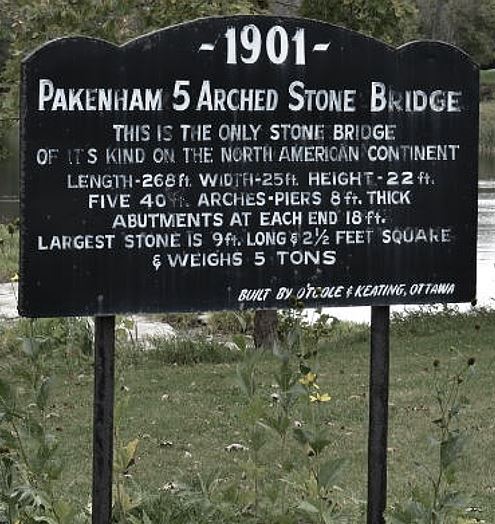
Mr. Robert Surtees of Ottawa prepared the blueprints and was the Engineer in charge of construction. William McDowall was the Inspector of the work, and Joseph Murphy of Arnprior was the book-keeper in charge of the budget while the work was in progress. George Quackenbush, local photographer, provided area newspapers with photos of the finished project.
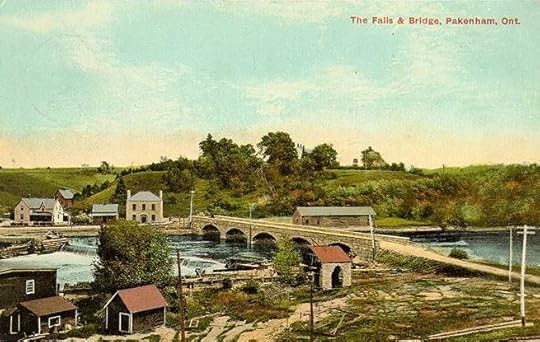
Postcard – 1910
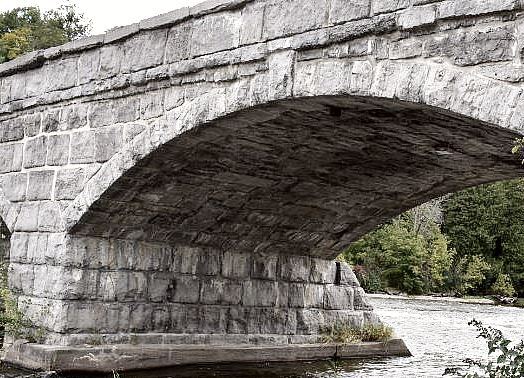
Detail of the arch construction
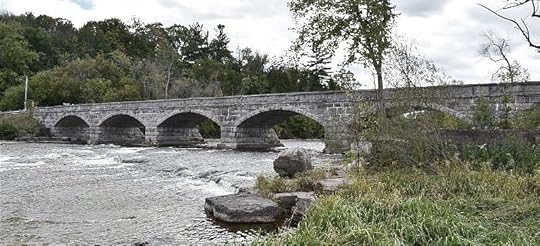
A view of the historic Pakenham bridge – the only one of its kind in Canada

Details from the placque at the bridge site
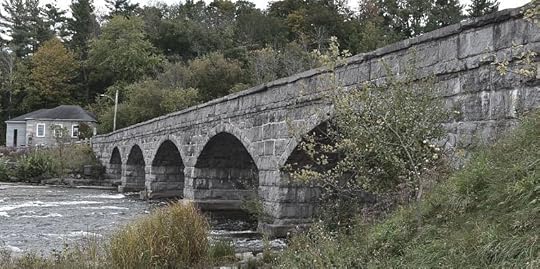
“Anyone who’s been to Pakenham will tell you that the awesome sight of this mighty river swelling and surging under the historic five-span bridge will remain forever etched in your memory. “

photo: Lanark County Tourism
Restoration in 1984
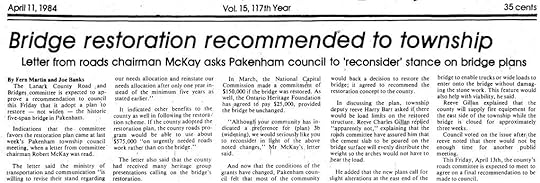
“The Almonte Gazette”

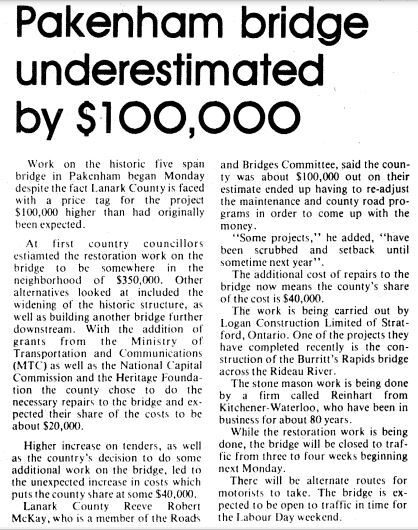
July 25, 1984, “Almonte Gazette”
The bridge was restored in 1984. The stones were carefully removed and cataloged, before being reinstated into their original position. A bed of reinforced concrete was set underneath the stones for additional strength.

Oct. 31, 1984, “Almonte Gazette”
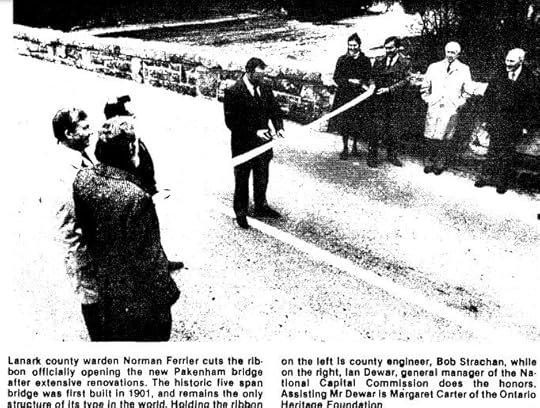
Nov. 21, 1984, p. 1 “Almonte Gazette”
Total Cost
The cost to build the bridge in 1901 was $15,400, including the construction of a temporary bridge for use during the project.
The 1984 restoration of the bridge cost $380,000. Of this, $150,000 was paid by the NCC (National Capital Commission, and $25,000 by the Ontario Heritage Foundation.
2007 Flag
Pakenham amalgamated with Almonte and Ramsay to form Mississippi Mills in 1998. The bridge was chosen as one of the principal symbols for their flag in 2007.

In the Movies
The 2020 Christmas movie, “Fatman”, (starring Mel Gibson, Walton Goggins and Marianne Jean-Baptiste) features a driving scene filmed on the Pakenham bridge.
Seven Wonders of Lanark County
Designated as one of the ‘Seven Wonders of Lanark County’, the Pakenham Bridge will continue to delight visitors and residents alike, with its breathtaking vistas, and rich history.
The bridge is located at 4916 Kinburn Side Road.
For a story set in Pakenham and the nearby Five-Span bridge:
“Lanark County Classics: A Treasury of Tales from Another Time – featuring the story, “Perils in Pakenham” Story features many local family names.

.

Arlene Stafford-Wilson
Member, Association of Professional Genealogists
Lanark County Pioneer Families Humanitarian Award
Honorary Life Member, Lanark County Genealogical Society
Francois Bregha Storyteller Award
Author of : “Lanark County Christmas”, “Lanark County Comfort”, “Lanark County Collection”, “Lanark County Calling”, “Lanark County Classics”, “Lanark County Connections”, “Lanark County Calendar”, “Lanark County Chronicle”, “Lanark County Kid”, & “Recipes & Recollections”
and “Lanark County Kitchen: A Maple Legacy from Tree to Table”



